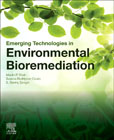
Emerging Technologies in Environmental Bioremediation
Shah, Maulin P.
Rodriguez-Couto, Susana
Sengor, S. Sevinc
Environmental pollution increases day by day due to increases in population, industrialization and urbanization, posing a threat to human health. The risk of adverse effects on health and on the environment caused by pollution has driven international efforts to combat pollutants. Bioremediation is the most effective innovative technology that uses live naturally-occurring microorganisms to degrade environmental pollutants and prevent contamination. Emerging Technologies in Environmental Bioremediation introduces emerging bioremediation technologies for the treatment and management of industrial wastes and other environmental pollutants for the sake of environmental sustainability. Emerging bioremediation approaches such as nano-bioremediation technology, electro-bioremediation technology, microbial fuel cell technology, Modified Ludzack-Ettinger Process, Modified Activated Sludge Process, and phytotechnologies for the remediation of industrial wastes/pollutants are discussed in a comprehensive manner not found in other books. Furthermore, the book includes updated information as well as future directions for research in the field of bioremediation of industrial wastes. This book is useful to students, researchers, scientists and professionals in the field of microbiology and biotechnology, Bio (chemical) engineers, environmental researchers, eco-toxicology, environmental remediation and waste managers, who aspire to work on the biodegradation and bioremediation of industrial wastes/environmental pollutants for environmental sustainability. Includes the recovery of resources from wastewaterDescribes the importance of microorganisms in environmental bioremediation technologiesPoints out the reuse of treated wastewater through emerging technologiesPays attention to the occurrence of novel micro-pollutantsEmphasizes the role of nanotechnology in pollutant bioremediation INDICE: 1. Bioremediation of Organic and Metal Co-contaminated Environments 2. New Bioremediation Technologies to Remove Metal (loids) and Radionuclides 3. Bioremediation of Soils Polluted with Hexavalent Chromium using Bacteria 4. Accumulation and Detoxification of Metal(loid)s by Plants and Microbes 5. Role of Phytochelatins in Phytoremediation of Heavy Metal(loids) 6. Metal(loid)s Resistance in Plants 7. Bioremediation of Metals 8. Phytoremediation of Metal(loids) and Radionuclides 9. Nanotechnology for Bioremediation of Heavy Metal(loid)s 10. Nitrate Pollution and its Remediation 11. Bioremediation of Petroleum Sludge 12. Diversity, Biodegradation and Bioremediation of Polycyclic Aromatic Hydrocarbons 13. Environmental Applications of Fungal and Plant Systems 14. Fungal-Based Remediation 15. Biofilms in Porous Media 16. Emerging technologies on Nanotechnology, Micro plastic degradation, Antibiotic 17.Case Study 18. Applications of bioinformatics and computational tools in environmental genomics and bioremediation of environmental pollutants 19. Field experience of Bioremediation and phytoremediation: Success stories and realism
- ISBN: 978-0-12-819860-5
- Editorial: Elsevier
- Encuadernacion: Rústica
- Páginas: 462
- Fecha Publicación: 01/05/2020
- Nº Volúmenes: 1
- Idioma: Inglés
